Affiliate links used below. See our full disclosure.
Lots of sensory bin/box ideas are floating around in the blogosphere and pop up on Pinterest from time to time.
As an occupational therapist, this is one play idea that I use very often, as most OT’s do, and I am kind of obsessed with them because of how many areas they can help a child develop.
So, I’ve put together a list of over 40 sensory bin ideas to inspire you and encourage your kid to get messy!
If you’re looking for more messy play outside of a sensory bin, head over to the Epic List of Messy Play Ideas!
What is a Sensory Bin?
It really is as simple as it sounds. A sensory bin is a box or bin, usually a Sterilite container that you fill with some kind of texture like dry rice.
The fillings of a sensory bin vary by texture, size, shape, and the play involved, but the goal is to expose your child to a range of sensory input for play.
Once you have the bin filled with any of the ideas listed below, throw a few toys in and let your kid dive in.
Sensory Bins are Awesome for Their Development
Sensory bins are great for kids because they provide loads of tactile stimulation and encourage imaginative play.
They’re also particularly helpful for children that are tactile defensive (sensitive to touching, wearing, eating different textures).
Because these bins usually catch the curiosity of a child, they will often push themselves out of their comfort level to explore in a way that they may not do on their own.
If you suspect that your child may have a limited diet because they don’t like certain textures of food, playing in sensory bins also helps desensitize them to various textures and may help them feel more comfortable with the textures they eat (read more about this in sensory processing and picky eating).
It sounds crazy that playing in a sensory bin with your hands can help picky eating, but it’s true! Also, sensory bins may be a great activity to include in a sensory diet, especially if your child has difficulty wearing clothing, as well as other sensory needs.
Beyond the obvious and huge sensory benefits, sensory bins help kids with body awareness, emotional regulation, cognitive development, and motor skills!
So basically, sensory bins are great for just about every kid! I am sure some of you are cringing at the thought of a bin of dry rice on your living room floor- it can be messy- but your kids are only kids once, so I say go for it!
Important Rules for Sensory Bin Play
Before you get started with any sensory bin, there are a couple of things you’ll want to keep in mind….
- Choking hazards: if your child is still putting everything into their mouth, be mindful of what you are putting into the bin. Many of the ideas listed below can work well for babies and toddlers. But, you can find a list of baby only bins here.
- Some textures have a shelf life, you may need to recycle or replenish some textures.
- NEVER, force your kid’s hand into a texture. If they don’t like it or are having a hard time touching it, respect that and don’t force it. Instead, encourage imitation from you and continue exposing them until they are more comfortable. Maybe they need to use a shovel before they can put their hand in and then maybe it is just a finger. You get the idea.
- Have towels ready for wet textures. Kids will wipe their hands off on you or the sofa, if you don’t. Also, if your child is tactile defensive, you want to have a towel on hand in case they start to freak out. By the way, letting them know the towel is there in case they need it will help them feel more comfortable touching the texture
40+ Easy Sensory Bin Ideas
If you want to make the leap into sensory play, but need some inspiration on what to put in a sensory bin, we’ve got you covered.
The goal here is to expose your kid to as many different textures and options as possible, so look through the list and pick a few to try! You can mix and match, and include your kids in deciding what to try next.
Dry Textures
-
- Rice
- Beans
- Split Peas
- Salt
- Corn Meal
- Coffee Grinds
- Birdseed
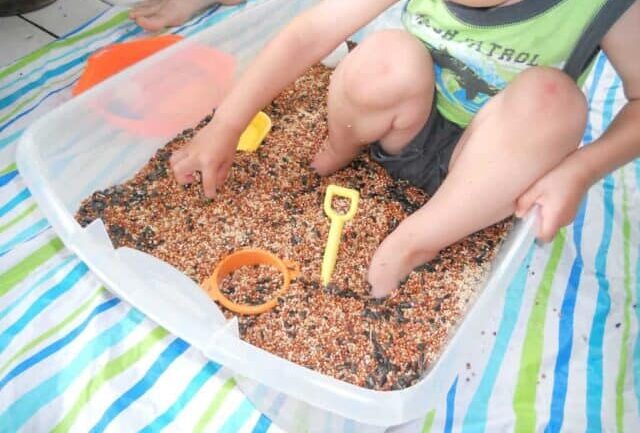
-
- Flour
- Cotton Balls
- Easter Grass
- Oatmeal
- Pasta
- Jelly Beans
- Seashells
- Acorns
- Popcorn Kernels
- Dirt
- Marbles
- Leaves
- Corn Husks
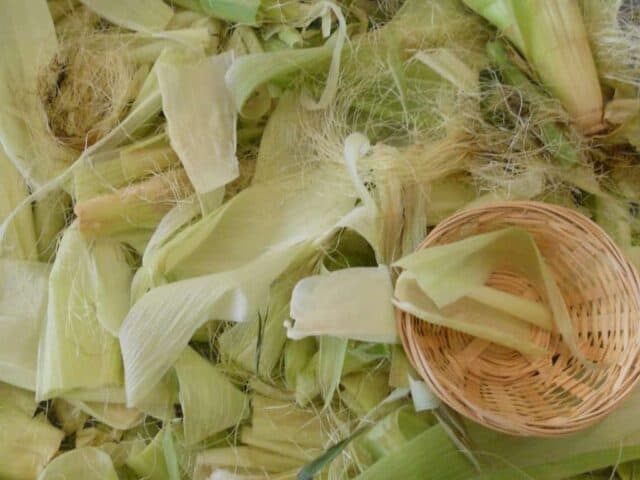
-
- Grass Clippings
- Craft Feathers
- Pom Poms
- Beads
- Shredded Mylar
- Packing Peanuts
- Cornstarch puffs (in the arts and crafts aisle)
- Easter Eggs (last three are great for babies)
- Scraps of Fabric
- Koosh Balls
- Pebbles
- Buttons
- Homemade Snow (baking soda and shaving cream)
- cereal
- sprinkles
Sensory Bin Ideas: Wet Textures
-
- Ice
- Water
- Snow
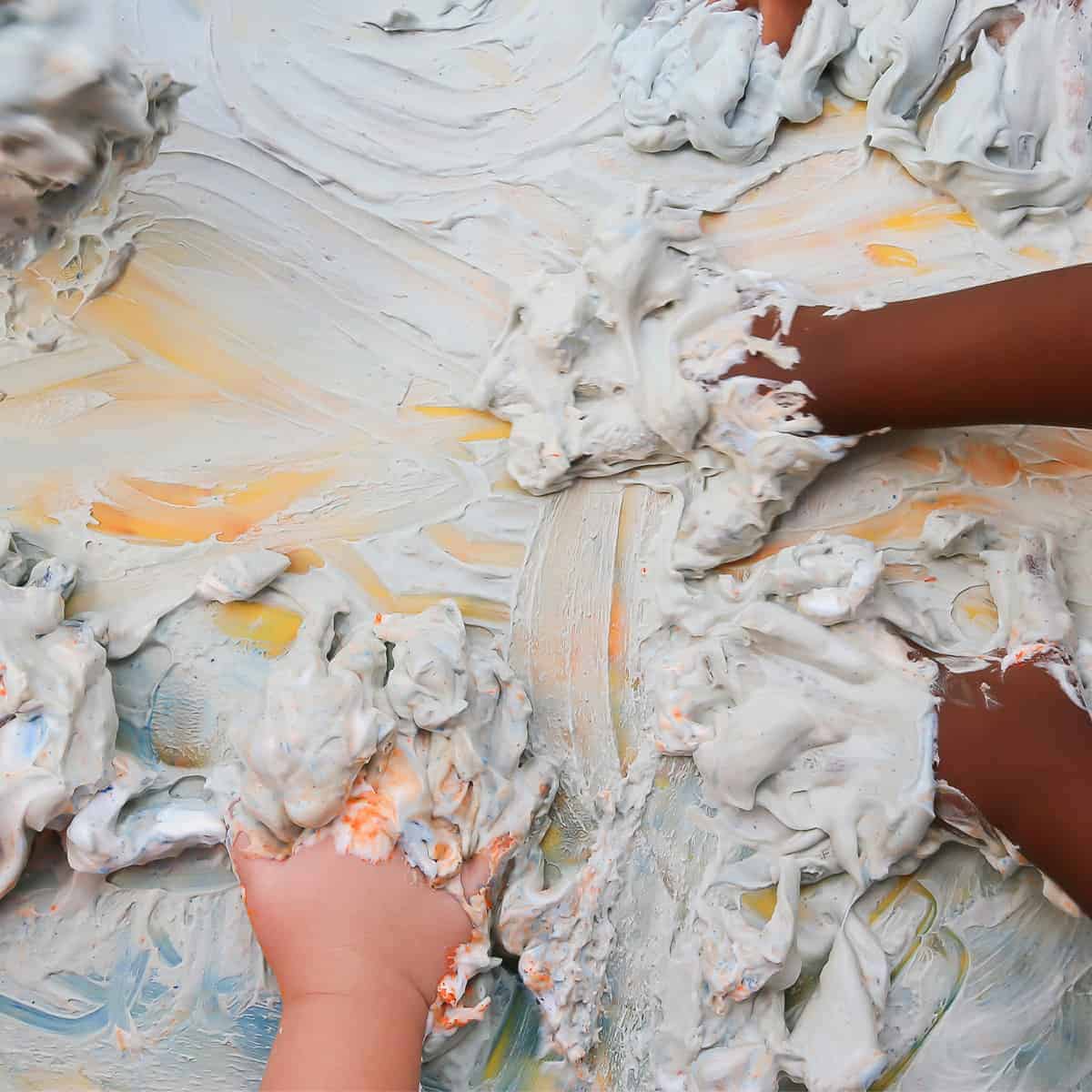
-
- Shaving Cream
- Soap Foam
- Pumpkin Guts
- Cooked Pasta
- Cooked Oatmeal
- Cooked Beans/Chick Peas
- Bubbles
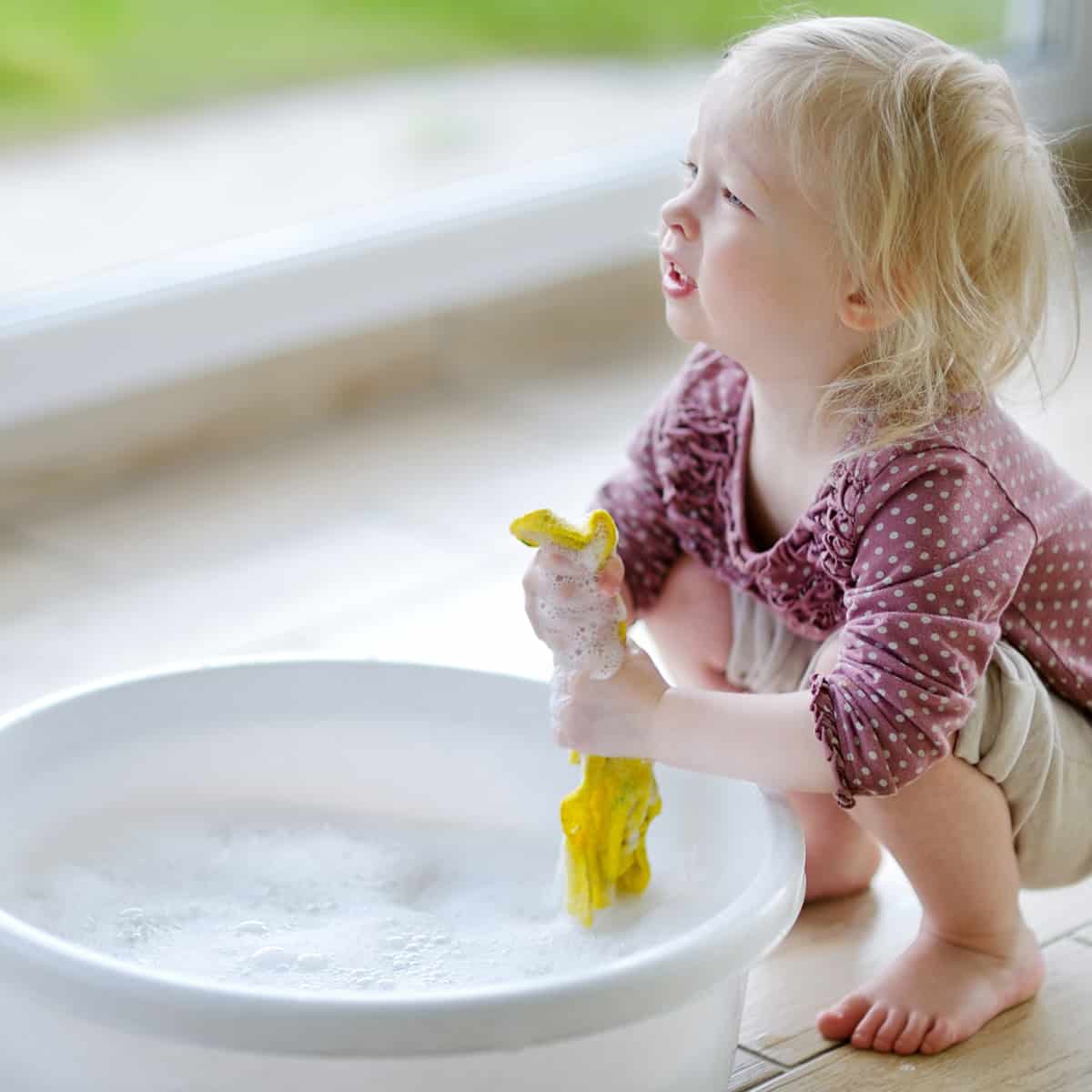
-
- Jello
- Pudding
- Whipped Cream
- Cornstarch and Water mixed together (aka Oobleck, get the recipe here)
How to Encourage Play in a Sensory Bin:
- First and foremost, let your child explore the bin without any input from you, which will allow their creativity to shine. You could set this up when you need a few minutes to wash up dishes or make a phone call. Of course, you can also sit with them, asking open ended questions.
- Have cups, scoops, bowls, shovels, serving spoons, dump trucks, and/or ladles in the bin for scooping and dumping. Scooping, dumping, and filling is a great play skill for toddlers, preschoolers can begin to learn some math concepts, and older kids can actually practice measuring and fractions.
- Draw or write letters with fingers in the different textures by making a smooth surface out of the texture on the bottom of the bin. Actually feeling the texture will reinforce shapes and the way letters are formed in the brain.
- Get creative with themes or learning concepts. Add artificial or real flowers to coffee (because it looks like dirt) so they can plant them. Or, use diggers and dump trucks to haul away the packing peanuts.
- Play hide and seek with various toys, seeing if your child can find them. Also, try giving directions to teach concepts like left/right, top/bottom, and shallow/deep. You could say something like, “The alligator is hiding on the left side.” Or, ” The rock is in the middle, but it is very deep.”
- Search with closed eyes. Lay some different objects shallow in the texture so that your kid can’t see. Have them search with just their hands and try to figure out what the object is without looking at it. This will help improve their tactile discrimination which will help them master fine-motor skills like handwriting!
- Get those feet in there! Bury feet and have them explore too, it is such a wonderful sensory experience! If your child is tactile defensive, feet are usually more sensitive than hands, so take it slow if you need to.
- Throw magnetic letters into the bin and have your kid hunt for them to spell their name or spelling words.
I come up with new sensory bin ideas all the time, the list is really endless. I will continue to add ideas, so make sure you pin this so you can check back.
And, if you have any sensory bin ideas, share them in the comments!
Learn How to Use Other Sensory Activities to Help Your Kid…
Sensory bins are an awesome sensory activity, but there are dozens more that can powerfully help your child whether they seek out or tend to avoid sensory play.
With the right sensory activities kids can improve attention, follow directions better, calm down, learn, fall asleep and more… Because when a child has sensory processing “issues” it affects every area of their life.
To learn more, get a seat in our free workshop: 3 Expert Secrets to Calm and Focus Your Child with Specialized Sensory Activities
Click here to get a free seat!
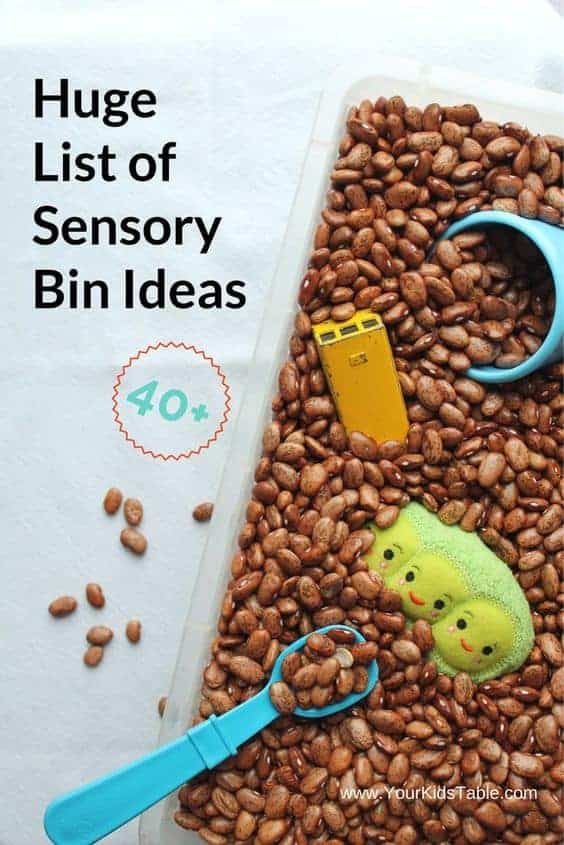
Did You Pin This?
More Sensory Ideas
How to Choose the Right Sensory Toy for Your Child
10 Sensory Red Flags That You Might Be Missing
Alisha Grogan is a licensed occupational therapist and founder of Your Kid’s Table. She has over 20 years experience with expertise in sensory processing and feeding development in babies, toddlers, and children. Alisha also has 3 boys of her own at home. Learn more about her here.
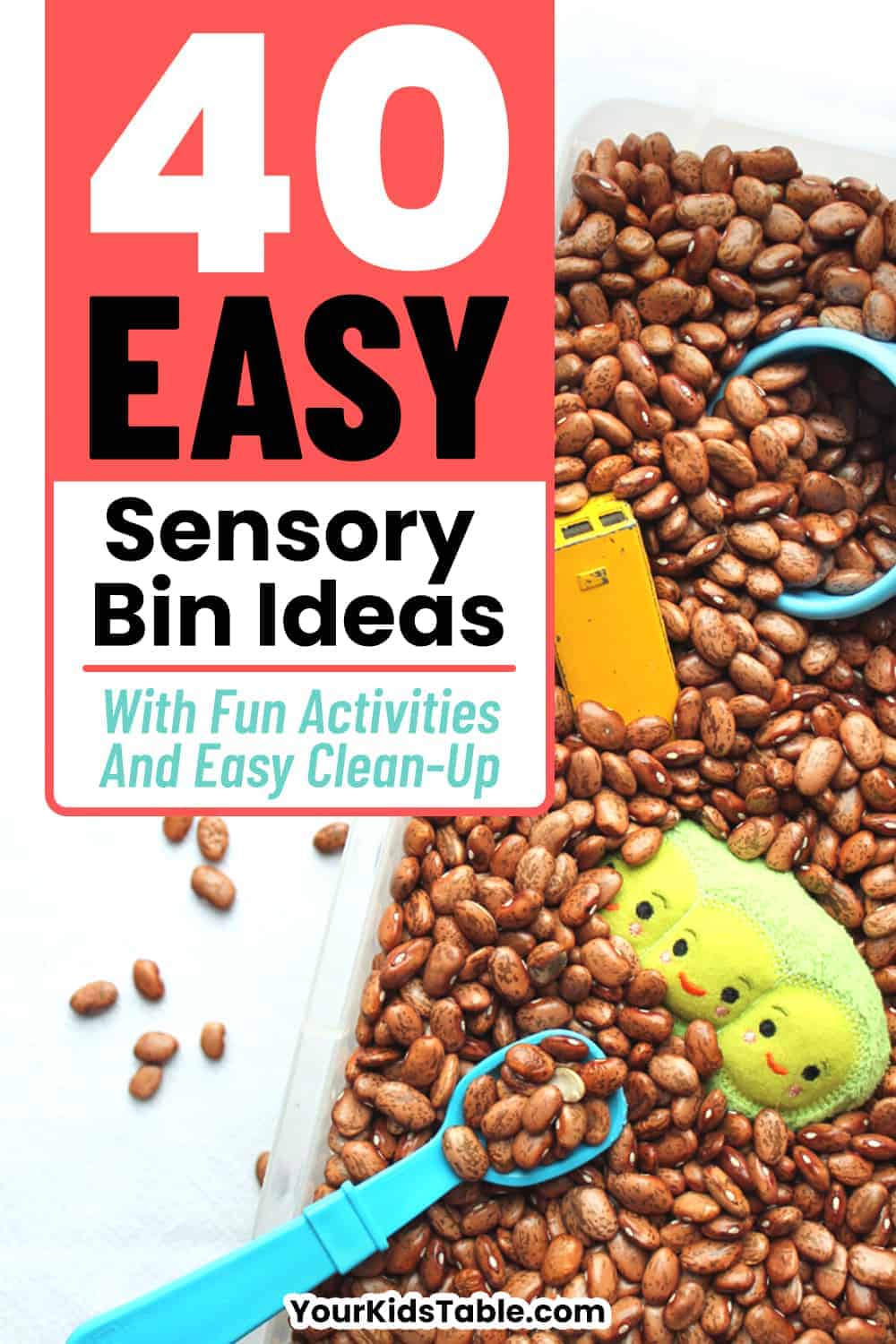
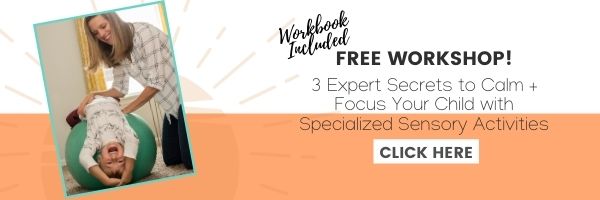
Hey can you please remove water beads and pictures from this article? Water beads are incredibly deadly and dangerous for babies
https://www.insider.com/expert-outlines-risk-of-water-beads-after-spate-of-accidents-2022-11
We have updated the post and all was removed!
can you make a post about small quit classroom fidgets I’m embarrassed about needing one
Hey Anna,
Thanks so much for reaching out! We actually do have a post for that! You can learn all about fidgets and which ones are more likely approved by the teacher here! Let us know if you have any other questions!
Best,
Desiree
thank you for responding I’m going o ask my mom for a pull and stretch stress ball for my birthday
Hi
After reading your information it describes my 2yr olds behaviour exactly.
My daughter is a twin who was born at 36weeks weighing just under2 kilos. There isn’t anything you happened to mention that didn’t discribe her eating habits, but all off this started after she turned 2. Everytime I take her to the doctors they tell me she is fine due to her weight fitting in the charts. I am really concerned and seek desperate advice and strategies to help.
Hi Mariam,
We know it can be so stressful when our kiddos don’t eat like we know they should. You aren’t alone in your struggles, so many other parents are dealing with this too. Our free picky eating workshop is a great place to start for ideas and strategies to start using right away. You can save your seat HERE.
Best,
Andrea
Hi! This list is definitely a huge list. There are a lot of things that I would not have thought of as a sensory filler if I had not come across your website (eg: corn husks).
I was wondering about the coffee grounds filler- I can imagine it to smell great, but would you use decaf coffee grounds to prevent the child from ingesting caffeine?
Yes, you can utilize decaf. However if there are concerns for child ingesting at a young age, you can utilize other options!
Best,
Desiree
I’m so glad that I came across your content. I have a two-year toddler who is very energetic and he simply cannot stay still for 5 seconds. I tried a rice + toy + spoon + cups in a plastic box as sensory bin for him and initially he stayed pretty occupied for about 30 minutes at one go and then played more with his brother for hours. I will try more and more indoor activities as its the safest within the environment I live in. Thanks again for sharing your ideas.
You are so welcome!!! So glad that you found us and found some great ideas for him! You may also like this Article full of great calming activities that also help regulate!
Best,
Desiree
Hi…i just started working with my picky eater and possibly sensory disorder 3 year old daughter…my daughter only eats rice, chicken nuggets, cheerios, and pasta, sometimes cheeseburger, cheese eggs..she looks disgusted when even touching wet fruit, mash potatoes, and even carrots…she also cant stand having dirty hands (with foods, paint, etc she doesnt cry but she holds her hands up in disgust until i coean them, sometimes she will say mommy clean hands, clean hands). So im wondering first of all could my daughter have a-sensory problem?, and if so would she require an OT?
These are red flags for sensory difficulties, especially with food. Sensory bins can be extremely powerful when they are used regularly in helping with these sensory sensitivities. It’s hard to say if she definitely needs therapy, but depending on what your insurance covers, it could be well worth having an evaluation.
Also, as another option, I teach an in depth picky eating course online that covers sensory issues with food. You can learn about it and my 3 best tips for picky eating in my free workshop.
Alisha, I have used sensory bins in my class. I never use food! With all the starving people in this world, Food Banks, etc. we should not be teaching our kids that food is a toy, then to be discarded. I use birdseed, beads, wooden beads, etc… they last forever.
Hey!
We do understand that this is not comfortable for everyone to utilize food, so we do encourage everyone to do what they are comfortable with. A lot of our audience has picky eaters and this can be a really great tool for getting them engaged with foods. But as always, do what you are comfortable with! Thanks for sharing.
Best,
Desiree
Hi daisy , my 2.5 years old son was exactly similar to your daughter. How did improve your daughter eating habit, I’m stressed a lot by seeing son not eating anything new. He eats exactly what your daughter ate, please advice me I don’t what to do and how to improve him.
Thanks
Kavitha
Hey Kavitha,
We know it can be really challenging to have a kiddo who is a picky eater. A great place to start is our free picky eating workshop. It gives you great ideas to start using right away! You can save your seat HERE. Let us know if you have any questions!
Best,
Andrea
Is there a printable list of sensory bin idea,I would love to have this handy
I’m sorry, I don’t have a printable made yet, but that’s a great idea!
Hi Alisha. I’m so happy to have found this website in my browsing for help in getting my 16 mth old to try solid foods. Weaning had been quite a challenge. I think i lacked guidance during that stage and so didn’t have much success which has now led to the predicament that we’re in. I’ve made some headway with self feeding fruit, bread, crackers and cheese but besides that, any other food hasn’t been successful. He doesn’t even want to take puree foods with a spoon!!! It’s quite difficult and extremely worrying for me as i’m attempting to prepare him for when he starts daycare/preschool. Before finding this website i wasn’t aware of the importance that sensory play could have and the link it may have to his eating behaviour. He likes to play with dry things like rice, oats and beans but anything moist is a no no. I thought he was probably just scornful. I think Would appreciate any advice you could give.
Hey Maria, that is huge key! Seriously so big. I just did a video on this in my free fb group. Sign in here, you’ll find it near the top, it will be so helpful for you: https://www.facebook.com/groups/pickyeating/
Then, sign up for the free sensory bin handout, it’s my rotation of what to use and when. I highly recommend grabbing that too, it’s just what you’re looking for. You can get it in fb messenger here: https://manychat.com/l2/yourkidstable
I’d use the play steps in this post to help him with the messy textures, it will take time and keep alternating them like I discussed in the video! You’re doing great!
What a great website. Thank you so much. My 26 months old never had oral phase and never made to table foods properly. I am still feeding him nutritious home made purees twice a day. He only eats a couple of biscuits, one bite of a toast and half a fishfinger if I am lucky. Speech therapist could not see any physical problem. We are working messy play for ages now. He has progressed and now comfortable with all dry textures, foam, bubbles. He still doesnt want to stick his hands into wet dough but he can tolerate it. When it comes to playing with food he would not play and avoid it like a plauge. Messy play is not helping at the moment. Is it a matter of time, are we supposed to wait for him to grow out of it or shall we find a way getting a referral for feeding clinic as it seems impossible as his weight is ok. Really love to hear your opinion. Many thanks
I would recommend getting a feeding evaluation, even though his weight okay. Check with your insurance first to see what is covered and talk to the clinic about their strategies before hand so you’re comfortable. I’d keep up with that messy play, if he resists a texture its a sign he needs more time with it. When kids are really sensitive to any texture I like to give them the chance to play in sensory bins daily for at least a month. It shouldn’t be the same texture everyday though, and using dry ones is still good (even if he plays in them easily!)
Alisha,thank you so much for your response. It means a lot for me. Unfrotunately I live in England and there is no way I can get a referral from my GP to a feeding clinic. Many health professionals has no knowledge of sensory based feeding problems. So we are on our own. I got one more question I will be obliged if you asnwer me. At the moment what we do is dry rice, kinetic sand, play dough which he is ok with them. He is not comfortable with finger painting but he can tolerate it with being really carefully handling, dry flour, and shaving foam. He came to the stage with foam that I hid little toys in it and he finds it but he is still very careful. What am I doing wrong? Is dry rice and beans the same thing? One type of grains is enough? When do kids start eating? When they are really comfortable with all the textures? Even though he made progress with his messy play I havent seen any progress with his eating.
Hi Fatma! These are all great questions. I actually just answered them all in a live video yesterday in my free picky eating group, I’d highly encourage you to join (are you on fb?) Get in here: https://www.facebook.com/groups/pickyeating/
Also, I gave a free handout all about the sensory bins, you can grab the link there or here: https://manychat.com/l2/yourkidstable
Tapioca balls (boba) can work as edible water beads, if you can afford them. I’m not sure these are great for a group setting as germs could easily be shared.
https://www.amazon.com/RAINBOW-BOBA-TAPIOCA-PEARL-2-2LB/dp/B003O9YUN2/ref=sr_1_8?ie=UTF8&qid=1513618422&sr=8-8&keywords=tapioca+pearls+rainbow
Great! Thank you!
I am actually pleased to glance at this web site posts which consists of tons of helpful facts, thanks for providing such
information.
I have a 23-month old girl with Down Syndrome. Is the bin supposed to be big enough for her to climb into/sit in, or just reach in to play? She does not seem bothered by textures but is just hesitant to pick stuff up, especially if it is handed to her, more willing to pick things up by herself. I am excited to try this with her, not something any of her therapists have mentioned.
Melanie
Hi Melanie- you can set it up any way you want, a larger bin provides more sensory stimulation and might be more motivating for a child. However, a small one might be sufficient to start. I would try and hide small toys she likes in the texture and have her put the texture into empty water bottles one at a time and then dump out. All of that is really good for fine motor development! Let me know how it goes!
Just made my first two sensory bins tonight. The cheapest and most effective play I’ve seen my son do in a long, long, long time. I did rice with some beach toys (small bucket, sifter, shovel, etc) and dry pinto beans with measuring cups and spoons. He has been playing at the kitchen table with this bin for almost 2 hours. this is unheard of with my son. I have seen the idea to use loose puzzle pieces in a sensory bin. What do you think would be an appropriate toy to go along with the puzzle pieces? I am at a loss at the moment.
So sorry that I just saw this! These bins are amazing and kids really do love them, so glad it has been a help to you. I say throw anything in there, it doesn’t have to make sense!
Hi all, thanks for all great ideas. I made one for my
10 month old with pingpong balls left over scraps of 15″ to 20″ pieces ribbons differ. type textures, small balls of yarn, fabrics or bandanas, baby wash cloths and container to put in and take out hope this was helpful=)
oh I tie knots on ribbons to a hair tie and make bows she loves to unravel and play peekaboo.
Thanks for sharing- awesome ideas!!!
I’ve been lurking for a while now. I have no words to tell you how much you’ve helped me and my 17 month old son. I’ve cried tears of joy and relief. Thank you so, so much.
Can’t tell you how much it means for me to hear that. Thank YOU!
I love these ideas and really think they will help my son with his sensory issues. I want to do these the right way, and how long does he practice or play with each bin–days, weeks? He will not touch “wet” or soft foods to put in his mouth. If he does not have issues with harder foods like crackers, toast should I still have him play with those types of bins? He is 11 moths old right now. P.S. thanks for your help with the straw/sippy cup!
Julie, there is no exact formula. Dry bins are a good place to start because they are less intense and they still give really good sensory feedback. However, with him only being 11 months old, I’m assuming he will try to put whatever you have in the bin, in his mouth. So, you may be a little limited there, for now.
Experiment with the wet textures, too. As I mentioned in the post, encourage don’t force. Make it as fun as possible.
As far as how long… Initially, follow his lead. He may really like it and let him play as long as he wants. If he doesn’t seem interested. Try to engage him by putting fun things into bin that he likes. You could put his blocks, cups, or little people in there. Also, give kitchen utensils because he may be more willing to try with a spoon, but not if he has to put his own hand in. Try for 5 minutes and then move on if he isn’t interested. Keep trying every day or two, trying different games to keep him interested.
Most kids love these bins, they are a good idea to have around and pull out from time to time. Since you are working to decrease sensitivity, keep playing with different textures, focusing on the ones that seem to make him uncomfortable. Keep playing with them regularly until he isn’t resistant to fully play in the texture.
Does that make sense? Hope it helps! I would love to hear how it all goes!
I am a pediatric SLP and I’m new to your blog. I love all your ideas! I work with children ages 0-3 and I’m always looking for new ideas. Thanks for your blog!
Thanks so much Simone, I appreciate it, especially from another therapist!
I am a pediatric SLP and I’m new to your blog. I love all your ideas! I work with children ages 0-3 and I’m always looking for new ideas. Thanks for your blog!
Awesome, thank you so much!
Did I totally miss the baby section?? My baby girl is 8 months, I’m a first time mom so I’m just trying to find ways to foster and encourage her ever growing curiosity! I love your blog!
Probably not, at the end of the first section I have parenthesis after the last couple of ideas that are totally safe for babies. There are many other’s in the list that are probably ok, but would require close supervision. I will have to revise the post because shaved ice, bubbles, and water are all great for babies too, but I didn’t mention that in the post. Check me out on Pinterest too because I have pinned a lot of interesting sensory play for babies.
At my school, Brevard Community College Lab School, we make sure every class room has a sensory bin. Thanks for some more ideas of what to put in them!In the winter we put potato flakes in for “snow.”
That is a great idea! I am thinking we may have a “snowy” july sensory bin. Thank you for sharing!
I love this list of sensory bin ideas. Very useful and I will be bookmarking it for future use. I will be featuring it on my weekly Kid’s co-op round up on Friday.
-Brittany
http://loveplaylearn.com
That’s great, Brittany! I am so excited to hear that, thanks so much for sharing and for passing it along!